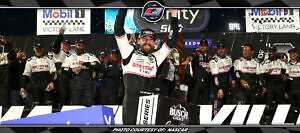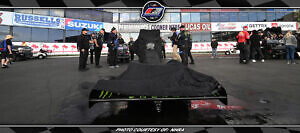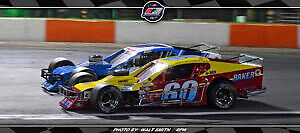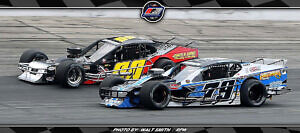
Story By: MATT CROSSMAN / NASCAR – DEARBORN, MI – Tony Stewart climbed into a Monster Energy NASCAR Cup Series car on Thursday for the first time since 2016. He fired the Mustang up, stepped on the gas, and felt the car roar to life underneath him. Alas, he never got out of second gear as he drove from Ford’s Flat Rock plant to the world headquarters in Dearborn.
Slow as that entry might have been, he got an ovation from the hundreds of fans on hand when he arrived at “Mustang Victory Circle” anyway, as Ford unveiled the Mustang that will compete in 2019 at the highest level of American motorsports for the first time.
Blue and white confetti rained down as Stewart climbed from the car. All of the Monster Energy Series Ford drivers—who followed Stewart to the unveiling in production Mustangs—watched with lust in their eyes, pounding in their chests and a little drool on their chins.
“The car guy in me wants to look at the lines and how sexy it is,” said Clint Bowyer, who drives for Stewart-Haas Racing. The NASCAR driver in him, Bowyer said, tries to figure out how fast it will be, and where engineers and crew chiefs will push to make it even faster.
“You put in the due diligence, put in the effort, in the hope it will perform better, obviously,” he said. “It’s like everything in life. You put your blood, sweat and tears into it. But you really don’t know until you go out and line her up and see what she does. With the technology and everything we have in today’s day and age, we think it’ll be bigger and better than we’ve ever had.”
This was a big week for the Mustang, Ford’s oldest car and the world’s best-selling sports coupe. In addition to the NASCAR news on Thursday, the 10 millionth Mustang rolled off the assembly plant in Flat Rock on Wednesday. Mark Rushbrook, global director for Ford’s motorsports activities, tried to push it one step farther, jokingly asking Steve O’Donnell, NASCAR’s executive vice president and chief racing development officer, if the Mustang could run in Sunday’s Consumers Energy 400 race at Michigan International Speedway (at 2:30 p.m. ET on NBCSN, MRN and SiriusXM NASCAR Radio).
The Mustang has a long history in racing. Its first race was in 1964, when it was a surprise winner of the Tour de France Automobile, a 10-day, 4,000-mile suffer fest. The Mustang has also competed in SCCA, Trans-Am, IMSA, NHRA, Formula Drift and NASCAR Xfinity (since 2011). But it has never competed at NASCAR’s highest level. That will change next year when it debuts in the Daytona 500 on February 17.
The Cup-level Mustang is the result of collaboration between NASCAR, Ford performance and design teams and NASCAR teams that field entries for the famed blue oval. Designers and engineers worked hard to create a car that will be both competitive and remain true to its heritage.
Jack Roush, owner of Roush Fenway Racing, knows plenty about both. He has fielded Fords for his entire career, which includes 3,565 races, 137 wins and two championships at the Cup level. He ordered his first Mustang in 1964—within 30 days of the new sports car’s debut on the market. Thirty days after that, he had a job inspecting Mustangs as they came off the assembly line. Nobody in NASCAR has such a tight connection to one model. “Mustang is a river that has run through me,” he says.
One day in the late 1960s, he took his Mustang for a ride headed south on I-75 from his home near Detroit. He looked up and saw police lights. He pulled over, and the police officer approached his car. “He told me I was ‘outclassing’ the traffic today,” Roush says. “I thought it meant I had a better car, so I considered that as a compliment.”
Roush again hopes his Mustangs outclass the field in 2019. But not in the same way. That Mustang—it was a blue 1964 ½ that Roush drove until it had 100,000 miles on it—was indeed a better car. But that’s not what the police officer meant. He meant Roush was speeding and wrote him a ticket.







